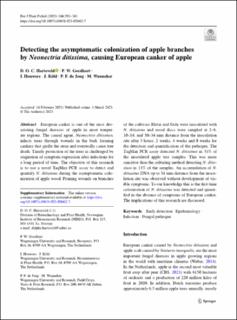| dc.contributor.author | Harteveld, Dalphy | |
| dc.contributor.author | Goedhart, Paul | |
| dc.contributor.author | Houwers, Ilse | |
| dc.contributor.author | Kohl, Jurgen | |
| dc.contributor.author | de Jong, Peter Frans | |
| dc.contributor.author | Wenneker, Marcel | |
| dc.date.accessioned | 2023-07-20T08:55:51Z | |
| dc.date.available | 2023-07-20T08:55:51Z | |
| dc.date.created | 2023-03-01T13:25:48Z | |
| dc.date.issued | 2023-03-01 | |
| dc.identifier.citation | European journal of plant pathology. 2023, 166 291-301. | en_US |
| dc.identifier.issn | 0929-1873 | |
| dc.identifier.uri | https://hdl.handle.net/11250/3080403 | |
| dc.description.abstract | European canker is one of the most devastating fungal diseases of apple in most temperate regions. The causal agent, Neonectria ditissima, infects trees through wounds in the bark forming cankers that girdle the stem and eventually cause tree death. Timely protection of the trees is challenged by stagnation of symptom expression after infections for a long period of time. The objective of this research is to use a novel TaqMan PCR assay to detect and quantify N. ditissima during the asymptomatic colonization of apple wood. Pruning wounds on branches of the cultivars Elstar and Gala were inoculated with N. ditissima and wood discs were sampled at 2–6, 10–14, and 30–34 mm distance from the inoculation site after 3 hours, 2 weeks, 4 weeks and 8 weeks for the detection and quantification of the pathogen. The TaqMan PCR assay detected N. ditissima in 51% of the inoculated apple tree samples. This was more sensitive than the culturing method detecting N. ditissima in 11% of the samples. An accumulation of N. ditissima DNA up to 34 mm distance from the inoculation site was observed without development of visible symptoms. To our knowledge this is the first time colonization of N. ditissima was detected and quantified in the absence of symptoms of European canker. The implications of this research are discussed. | en_US |
| dc.language.iso | eng | en_US |
| dc.publisher | Springer | en_US |
| dc.title | Detecting the asymptomatic colonization of apple branches by Neonectria ditissima, causing European canker of apple | en_US |
| dc.title.alternative | Detecting the asymptomatic colonization of apple branches by Neonectria ditissima, causing European canker of apple | en_US |
| dc.type | Peer reviewed | en_US |
| dc.type | Journal article | en_US |
| dc.description.version | publishedVersion | en_US |
| dc.rights.holder | © The Author(s) 2023 | en_US |
| dc.source.pagenumber | 291-301 | en_US |
| dc.source.volume | 166 | en_US |
| dc.source.journal | European journal of plant pathology | en_US |
| dc.identifier.doi | 10.1007/s10658-023-02662-7 | |
| dc.identifier.cristin | 2130465 | |
| cristin.ispublished | true | |
| cristin.fulltext | original | |
| cristin.qualitycode | 1 | |
